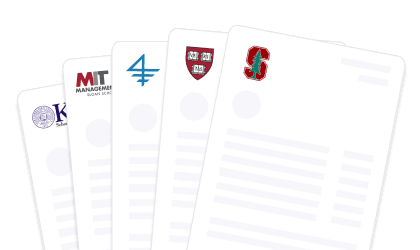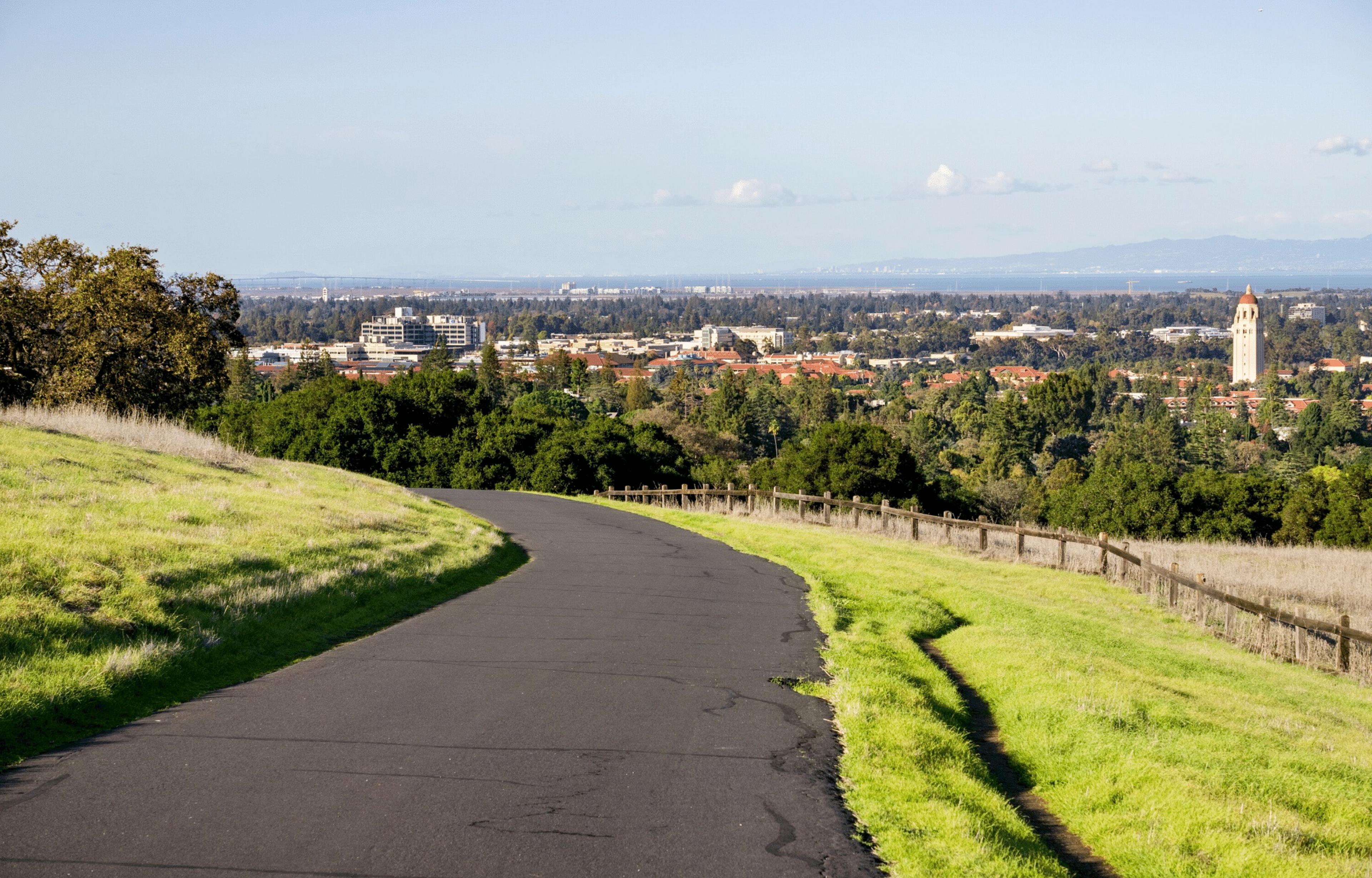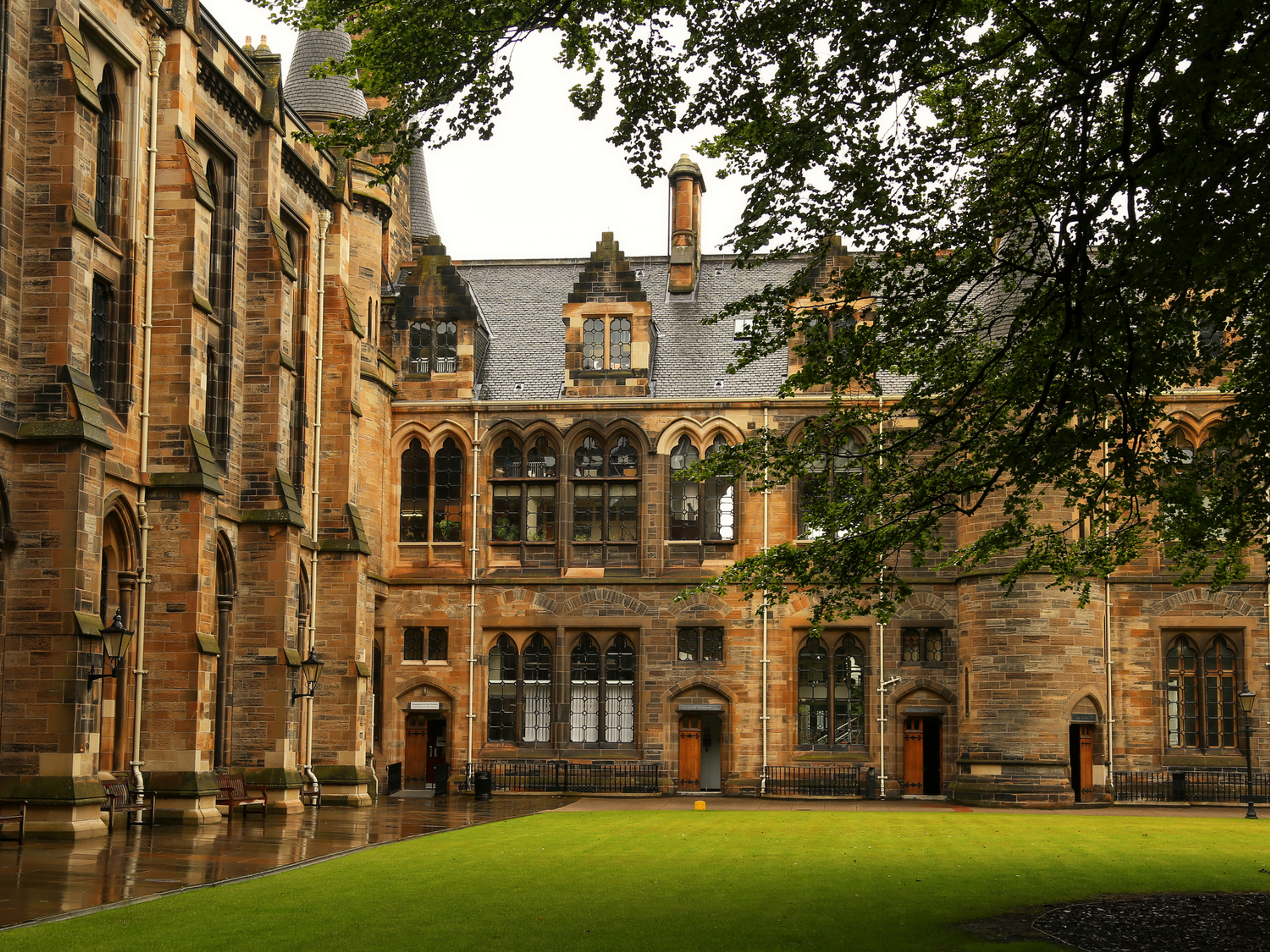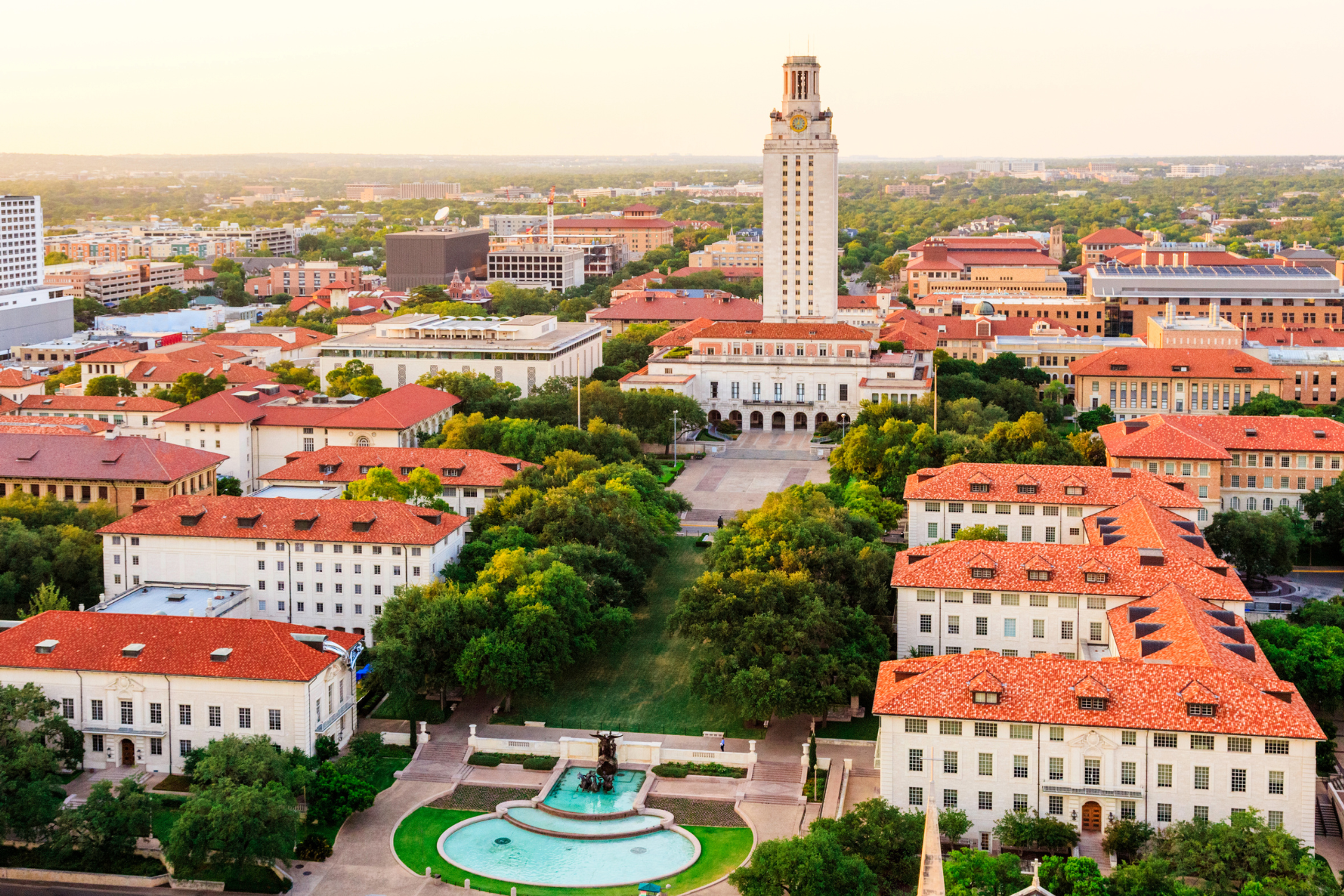
Join a free event
Learn from top coaches and industry experts in live, interactive sessions you can join for free.
Table of Contents
If you’re considering Stanford Graduate School of Business (GSB), you’re probably not looking for a one-size-fits-all MBA. You want flexibility, real-world application, and the freedom to design a program that fits your goals, and not someone else’s. But what does that actually look like?
The Stanford GSB offers a comprehensive MBA curriculum that combines core courses, elective options, and specialized areas of study. This article explores the different components of the Stanford GSB MBA curriculum and their significance in shaping students' educational experience and career outcomes.
By the end, you’ll know exactly how Stanford’s MBA works, what makes it different from other top programs, and how to make the most of your two years on campus.
What Is Stanford GSB MBA Curriculum?
The Stanford GSB MBA program is a two-year, full-time degree designed to build strong leadership, critical thinking, and global business skills. The curriculum is known for its flexibility, personalization, and strong focus on personal development.
First-Year Curriculum
In the first year, all students take a core set of classes that build a foundation in business fundamentals:
Core Requirements
- Data and Decisions
- Leading with Values
- Finance I
- Financial Accounting
- Leadership Laboratory
- Managing Groups and Teams
- Microeconomics
- Optimization and Simulation Modeling
- Organizational Behavior
Distribution Requirements
- Finance II
- Human Resource Management
- Information Management
- Macroeconomics
- Managerial Accounting
- Marketing
- Operations
- Strategy
- Strategy Beyond Markets
Global Experiences
Stanford GSB's Global Experience is a core part of the first-year MBA curriculum -- it's how they develop leaders who can work and lead across cultures.
In fact, you’re required to complete at least one global experience before the end of your first year. But the way you do it is up to you.
Think of it less like a study abroad program and more like real-world leadership training across borders. You’ll get to pick from several hands-on, immersive options, each designed to challenge you to step outside your comfort zone and engage with global business, social, and policy issues.
Here’s what that could look like:
- Global Study Trips: Faculty-led, intense 10-day deep-dives into industries or themes in a specific country. These include company visits, cultural events, and even meetings with government or nonprofit leaders.
- Global Management Immersion Experience (GMIX): A four-week summer internship-style project where you work on a business or social impact challenge, usually in a developing economy. Students often describe this as a crash course in humility, resourcefulness, and cross-cultural teamwork.
- Stanford-Tsinghua Exchange Program: A dual-part program with Tsinghua University in China; one week in Beijing, one week in the Bay Area. It’s a powerful exchange of ideas between two of the world’s top business schools.
- Self-Directed Global Experiences: For the truly entrepreneurial, you can propose your own project or research with a global focus. It just has to meet the school’s criteria.
What’s the point of all this? Stanford knows that leadership today means global leadership. These experiences are about learning how to build trust across cultures, solve messy real-world problems, and see business through a global lens.
Read: Stanford GSB MBA: Acceptance Rate, Deadlines, Cost, Requirements, & Program Overview
Second-Year Curriculum
In your second year at Stanford GSB, the curriculum shifts entirely to electives, offering you the flexibility to tailor your MBA experience to your personal and professional goals. This approach allows you to deepen your expertise in specific areas, explore new subjects, and round out your general management education.
Elective Courses
Stanford GSB continually updates its elective offerings to reflect changes in the business world, social sector, and faculty interests. This dynamic curriculum ensures that you can engage with contemporary issues and emerging trends. Electives span a wide range of topics, including but not limited to:
- Accounting:
- Alphanomics: Informational Arbitrage in Equity Markets
- Analysis and Valuation of Emerging Markets
- Financial Statement Analysis
- Finance:
- Angel and Venture Capital Financing for Entrepreneurs and Investors
- Capital Markets and Institutional Investing
- Chief Financial Officer (CFO) Leadership
- Debt Markets
- Economics of the Private Equity Industry
- Financial Restructuring
- Financial Trading Strategies
- Investment Management and Entrepreneurial Finance
- Private Equity — An Overview of the Industry
- Economic Analysis and Policy:
- Economics of Labor: Strategy, Policy, and the Future of Work
- Measuring Impact in Business and Social Enterprise
- Marketing:
- Consumer Behavior
- Go-to-Market
- Persuasion: Principles & Practice
- Understanding AI Technology for Business Problems
- Organizational Behavior:
- Interpersonal Dynamics
- The AI-powered Org: Evolution, Rebirth or Death?
- Negotiations
- Operations, Information & Technology:
- Design for Extreme Affordability
- Biodesign Innovation: Needs Finding and Concept Creation
- Biodesign Innovation: Concept Development and Implementation
- Political Economics:
- Energy: Innovation, Policy & Business Strategy
- Finding Religious and Spiritual Meaning at Work: Business Exemplars
- Global Business, Religion, and National Culture
- The Future of Cities: Entrepreneurship, Policy and Business Strategy
- Strategic Management:
- Competitive Strategy for Technology Markets
- Conversations in Management
- Entrepreneurial Acquisition
- Health Information Technology and Strategy
- Strategies of Effective Product Management
- General & Interdisciplinary:
- Assessing and Developing Leadership
- Climate Finance in Private Markets
- Strategic Philanthropy and Impact Investing
- Political Communication: How Leaders Become Leaders
- Problem Solving for Social Change
- Public Policy for Climate Innovation
- Real Estate Investment
These electives are designed to provide practical knowledge and skills, preparing you to lead effectively in various sectors and industries.
See the complete Academic Area courses here.
Customization and Cross-Registration
Beyond GSB electives, you have the opportunity to enroll in courses across Stanford University, including schools of Law, Medicine, Engineering, and Humanities and Sciences. This cross-disciplinary approach enables you to gain diverse perspectives and skills relevant to your interests.
Social Innovation
Stanford GSB's Social Innovation program uses business as a force for good, blending sharp strategy with bold purpose to take on real-world problems like climate change, global health, education equity, and economic inclusion.
Whether you're building a startup that rethinks access to care or pushing for sustainable change inside a Fortune 500, Stanford gives you the space, the tools, and the support to make it happen. With hands-on experiences, mission-driven coursework, startup funding, and a community of changemakers behind you, the goal is simple: help you turn big ideas into measurable, lasting impact.
Want to know more about the classes at Stanford GSB? Read The 5 Best Classes at Stanford’s Graduate School of Business and The Best Professors at Stanford GSB
Specializations Offered in the Stanford GSB MBA Program
While Stanford GSB's MBA program is known for its flexibility and broad-based leadership training, it also offers specializations for students who want to go deeper into a specific area of business. These specializations are more than just a curated set of electives, but they’re an opportunity to build real expertise aligned with your long-term goals.
Whether you're drawn to finance, entrepreneurship, social innovation, or global management, these tracks give you the tools to dive deep, connect with like-minded peers, and tailor your learning experience to match your professional ambitions. They’re especially valuable for students entering competitive industries or those looking to pivot careers with a strong foundation in a new area.
Not sure if Stanford’s curriculum is right for your goals? Talk to a coach who’s been there:
- Ben L. -- Stanford GSB Alumnus (Class of 2021), Worked at McKinsey & Company
- Mike H. -- Stanford GSB Alumnus, Former Director of MSx Program and Admissions and Executive Director Center for Leadership Development and Research at Stanford GSB
- Angela C. -- Stanford GSB Alumna, H/S/W and M7 Specialist
Stanford MBA Joint and Dual Degree Options
Around 20% of Stanford MBA students pursue an additional degree, making joint and dual degree programs a popular path for those looking to deepen expertise across disciplines.
Joint Degree Programs (Within Stanford)
In a joint degree, certain courses count toward both the MBA and the second degree, saving time and tuition. However, you can only pursue one joint degree with the Stanford MBA. Available pairings include:
- MA in Education
- MPP (Master in Public Policy)
- MS in Computer Science
- MS in Electrical Engineering
- JD/MBA (Law)
- MS in Environment and Resources
You may not combine two joint degrees from this list.
Dual Degree Programs (Within Stanford)
Dual degrees also combine the MBA with another graduate program, but each course counts toward only one degree. Students pursuing the MD/MBA at Stanford follow this structure. Like joint degrees, only one additional degree may be pursued alongside the MBA.
Off-Campus Dual Degree Options
Stanford MBA students can also arrange dual degrees with external institutions. Some of the most popular off-campus pairings include:
- Harvard Kennedy School – MPA, MPA-ID, or MPP
- Harvard Medical School – MD
- Johns Hopkins SAIS – MA in International Studies
- Princeton School of Public and International Affairs – MPA
- Yale Law School – JD
- Yale School of Medicine – MD
These combinations allow students to build specialized expertise while maximizing the strategic value of the MBA.
Bottom Line
From the structured core curriculum in year one to the open-ended electives, global experiences, and cross-disciplinary opportunities in year two, the program is built to help you develop both the business concepts and the self-awareness needed to lead in today’s world.
But here’s the real question: What kind of learner are you? Do you thrive with structure, or do you want the freedom to shape your own path? Are you looking to sharpen traditional managerial skills, or are you here to push into uncharted territory; maybe launching a venture, solving global challenges, or growing into a new version of yourself?
Stanford’s curriculum gives you the tools. The real challenge, and opportunity, is deciding how to use them. So as you explore this next step, ask yourself: What do I need most out of an MBA, and am I ready to build it?
Read next:
- Stanford GSB Costs: MBA Tuition & Fees Breakdown (With Scholarships)
- Stanford GSB MBA Acceptance Rates
- 5 Expert Tips for the "Why Stanford?" MBA Application Essay
Final Note
Leland provides you with the content, community, and coaching that you need to get into your dream MBA program and accomplish other ambitious goals. Sign up today to gain access to additional free resources, community events, small group classes, world-class coaching, and more.
Stanford GSB MBA Curriculum FAQs
What is the teaching method of Stanford MBA?
- The Stanford MBA program uses a mix of case studies, group projects, simulations, and real-world experiences to build both analytical and interpersonal strengths. The goal is to help students sharpen their communication skills and decision-making in a variety of business settings.
What is the curriculum of an MBA?
- An MBA curriculum typically blends theory and practice in areas like finance, marketing, operations, and leadership. At Stanford GSB, the comprehensive curriculum ensures students gain a solid grounding in core business areas while developing the flexibility to explore advanced topics and global issues.
What are the required core courses at Stanford GSB?
- The core curriculum at Stanford GSB includes foundational courses like financial accounting, economics, data analysis, strategy, and organizational behavior. These are designed to build strong managerial skills and prepare students to lead across industries.
How customizable is the MBA curriculum?
- Highly customizable. After completing the components of the Stanford MBA curriculum in the first year, students can choose from 100+ electives, explore dual-degree options, and tailor their academic path to match personal and professional goals.
What kinds of electives are offered, and how do students choose them?
- Electives cover a wide range -- from entrepreneurship and social innovation to finance and tech. Students are encouraged to develop expertise in areas that align with their long-term career interests. Advising, peer input, and trial-and-error help guide these choices.
How difficult is it to get into Stanford MBA?
- It’s extremely competitive. The Stanford MBA class profile typically includes students with strong academic backgrounds, diverse experiences, and leadership potential. The school looks for candidates who can bring unique perspectives and thrive in a collaborative environment.
What is the median salary for Stanford MBA?
- Graduates of Stanford GSB report a median salary of over $175,000, not including bonuses and other compensation. This reflects the program’s strength in preparing students for high-impact roles, particularly in consulting, finance, and tech.
What experiential learning or global programs are part of the curriculum?
- Stanford offers rich experiential learning opportunities, including global study trips, immersion programs, and real-world consulting projects. These programs give students a deeper understanding of global markets, cultures, and leadership challenges.
How does the curriculum support entrepreneurial or non-traditional paths?
- Stanford is a standout for students pursuing entrepreneurship or impact-driven careers. The curriculum supports these goals through startup labs, venture funding, and courses that help aspiring founders and corporate managers build innovative solutions to real-world problems.
How does Stanford’s curriculum differ from HBS or Wharton?
- Stanford places a unique focus on ethical leadership, personal development, and flexibility. Compared to more structured programs like HBS, Stanford offers greater freedom to shape your journey and explore new business concepts with depth and creativity.
Browse hundreds of expert coaches
Leland coaches have helped thousands of people achieve their goals. A dedicated mentor can make all the difference.



























